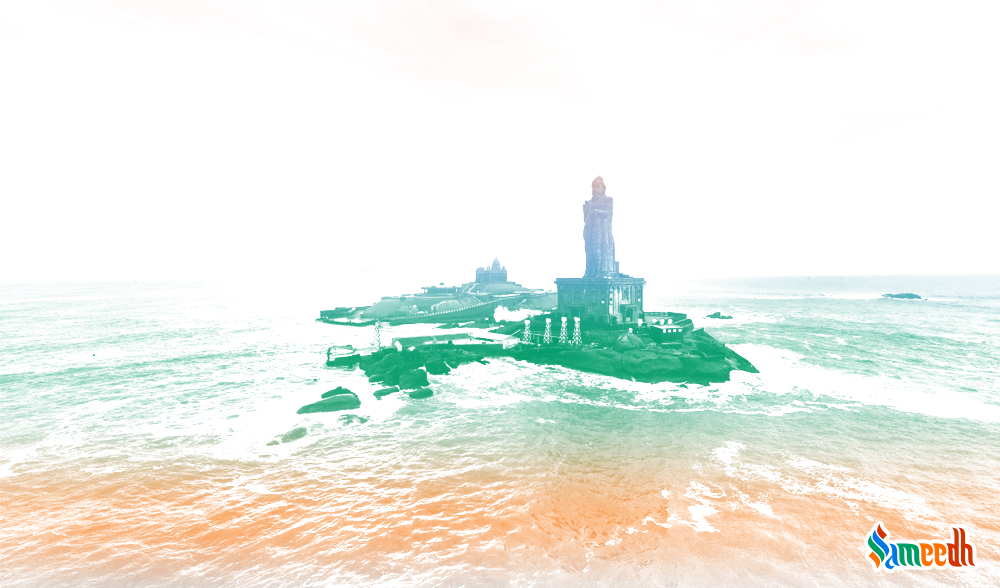Kanyakumari is always mentioned when describing the Indian sub-continent as it represents the southernmost extremity. Is that all or there is more to it than this…

LOCATION
It is located at the southernmost tip of mainland India, at the confluence of the Bay of Bengal, the Arabian Sea, and the Indian Ocean. The Kanyakumari Temple is one of the 52 Shakti Peethas.
MYTHOLOGY
The mythological story dates back to the prehistoric Tamil period. ‘Banasur’, a demon by birth, was the ruler of this land. He had a boon from Lord Brahma that his death was possible only by the hands of an adolescent young girl. This made him fearless and he wreaked havoc on the entire world. He ousted Lord Indra from his throne and banished all the devas from heaven. It is believed that Bhagvati, the unbiased Prakriti manifested herself in the Southern tip of ‘Aryavart’ as Kumari, to kill Banasur and reset the balance of nature. Banasur, tried to approach Kumari without realizing who she was. This infuriated Kumari, who was Bhadrakali herself, and she slaughtered Banasur at once. Moments before his death Banasur realized that the one before him was none other than Adi Parashakti and he prayed her to absolve him of his sins. After killing Banasur, Kumari assumed her original form of Parvati and reunited with her husband Shiv. Kumari maintained her divine presence in the place, in the Bhagvati Kumari Temple.
SIGNIFICANCE
Devi Kanya Kumari is the manifestation of Adi Parashakti in the form of an adolescent girl child. Legend attributes Sage Parashuram for performing the consecration of the temple. This temple is believed to be more than3000 years old. The goddess is said to remove rigidity of the mind. The Kanyakumari Temple is one of the 52 Shakti Peethas where the right shoulder and back of Sati’s corpse is said to have fallen, creating the presence of Kundalini Shakti in the region. It is one of the 108 temples of Goddess Durga – known as Durga Alayas. The goddess is considered as Katyayani, one of the Navdurgas here. Devi Kanya Kumari is the goddess of virginity and penance. It is a practice that people choose to receive the deeksha of Sanyas from here during the times of yore. The rites and rituals of the temple are organised and classified according to Shankaracharya’s treatise.
The worship of Devi Kanya Kumari here dates back to the ‘Kumari Kandam’, an ancient missing land. Devi Kanya Kumari has been mentioned in Ramayan, Mahabharat, and the Sangam works ‘Manimekalai’, ‘Puranaanooru’ and Narayan Upanishad, a Vaishnava Upanishad in the Taittiriya Samhita of Krishna Yajur Ved. The location of Kanyakumari has been held sacred by Hindus’ as it is the confluence of three seas. Offering Pitru Tarpan and bathing in the sea in the Kanyakumari is considered holy because it is the convergence of many important Theerths. There are 11 theerths associated with the temple in the ocean surrounding Kanyakumari.
TOWN’S MAIN ATTRACTIONS
The other attractions in Kanyakumari are the Pathal Ganga Theerth, Kalbhairav Shrine. Kalbhairav is a ferocious form of Lord Shiv who annihilates Kala or time itself. The name of the Kalbhairav in Kanyakumari temple is ‘Nimish’ and that of the Shakti is ‘Sarvani’ and in the Shakti Peeth of Shuchindram the Kalbhairav is ‘Samhara’ and the Shakti is ‘Narayani’. There are also shrines to Vijayasundari and Balasundari, friends and playmates of the Goddess in her youthful form. Shri Pada Para is a rock in the shape of Kumari’s feet which is now famous as Vivekananda rock memorial, where Swami Vivekananda got enlightenment.
The presiding deity’s idol is carved from blue stone in a standing posture with an ‘Akshamala’ in her hands. There is an image of a lion in her pedestal indicating that she is the form of Adi Parashakti. The most attractive feature of the temple is the diamond nose ring on the Kanya Kumari Idol. It is said that this nose ring was obtained from the king Cobra. The nose ring’s shine is so bright that it can be visible from far away at night. There is a four-pillar hall in the temple, each of which gives out sounds of Veena, Mridangam, flute and Jaltarang. Though the temple is located on the seashore, the water of the temple well is also known as Mool Ganga Teerth. It is sweet and during the full moon day, devotees and tourists can view the sun set and moon rise at same time. It is said that whoever takes a dip here will wash her/his sins for the lifetime.
HOW TO REACH
Kanyakumari is very well connected with the cities. The nearest Railway Station is Kanyakumari Railway Station at a distance of 1 km. The nearest air connectivity is in Trivandrum International Airport at a distance of 67kms.
To know more about Hinduism, its places of religious importance, pilgrimage routes, its famous temples, etc. or for any special need like conducting a pooja at your home please visit our website Sameedh.
